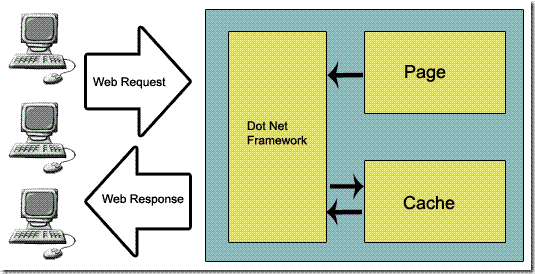ASP.NET缓存

介绍
缓存是在内存存储数据的一项技术,也是ASP.NET中提供的重要特性之一。例如你可以在复杂查询的时候缓存数据,这样后来的请求就不需要从数据库中取数据,而是直接从缓存中获取。通过使用缓存可以提高应用程序的性能。
主要有两种类型的缓存:
1.输出缓存Output caching
2.数据缓存Data caching
1. 输出缓存(Output Caching)
使用输出缓存,你可以缓存最后输出的HTML页面,当相同的页面再次请求的时候,ASP.NET不会再执行页面的生命周期和相关代码而是直接使用缓存的页面,语法如下:
<%@ OutputCache Duration=”60” VaryByParam=”None” %>
Duration 属性设置页面将被缓存60妙。任何的用户请求都会被缓存,在缓冲的60秒内相同的请求都会直接使用缓存的页面。当缓存过期后ASP.NET会再次执行页面代码并且为下一个60秒创建一个新的HTML缓存。
<%@ Page Language="C#" MasterPageFile="~/MasterPage.master" AutoEventWireup="true" CodeFile="OutputCachingTest.aspx.cs" Inherits="OutputCachingTest" Title="Untitled Page" %> <%@ OutputCache Duration="20" VaryByParam="None" %> <asp:Content ID="Content1" ContentPlaceHolderID="ContentPlaceHolder1" runat="Server"> <div class="title">Output Cache</div> Date: <asp:Label ID="lblDate" runat="server" Text="" /> Time: <asp:Label ID="lblTime" runat="server" Text="" /> </asp:Content>
protected void Page_Load(object sender, EventArgs e) { lblDate.Text = DateTime.Now.ToShortDateString(); lblTime.Text = DateTime.Now.ToLongTimeString(); }
在这个例子中页面将被缓存20秒。
通过查询字符串缓存(Cache by Query String )
在实际应用中页面往往会根据一些参数动态的改变页面的内容。如果你的页面是通过查询字符串来获取信息的,你可以根据查询字符串很容易的缓存页面的不同拷贝。VarByParam=”None”指定ASP.NET只存储缓存页面的一个拷贝。VarByParam=”*” 指定ASP.NET根据不同的查询字符串存储不同的缓存页面。
<%@ OutputCache Duration="60" VaryByParam="*" %> <div align="right"> <a href="OutputCachingTest2.aspx">No Query String</a> | <a href="OutputCachingTest2.aspx?id=1">ID 1</a> | <a href="OutputCachingTest2.aspx?id=2">ID 2</a> | <a href="OutputCachingTest2.aspx?id=3">ID 3</a> | <a href="OutputCachingTest2.aspx?id=3&langid=1">ID 3</a> </div>
上面的例子中,在查询字符串中传了不同的ID.ASP.NET为每一个ID都存储了单独的缓存页面。这种方式会有一些问题就是当查询字符串范围很广的时候。
这个时候我们可以在VarByParam属性中指定重要的查询字符串变量的名字,如下:
<%@OutputCacheDuration="60"VaryByParam="id;langid"%>
这样,ASP.NET可以根据id” or “langid”来缓存不同的缓存版本。
自定义缓存(Custom Caching)
你也可以创建自定义的程序来缓存页面。ASP.NET提供了一种很便捷的方式来创建自定义缓存,使用VarByCustom属性指定自定义缓存类型的名字。
%@OutputCacheDuration="20"VaryByParam="None"VaryByCustom="browser"%
你还要创建为缓存生成自定义字符串的方法,如下:
public override stringGetVaryByCustomString(HttpContext context, stringcustom)
{
if(custom == "browser")
{
returncontext.Request.Browser.Browser +
context.Request.Browser.MajorVersion;
}
else
{
return base.GetVaryByCustomString(context, custom);
}
}
这个方法必须写在global.asax文件中。ASP.NET使用该方法返回的字符串来实现缓存,如果这个方法在不同的请求中返回相同的字符串,ASP.NET就会使用缓存的页面,否则就会生成新的缓存版本。
上面的例子中GetVaryByCustomString()方法根据浏览器的名字创建缓存字符串,ASP.NET会根据不同的浏览器请求创建不同版本的缓存。
控件缓存(Control Cache )
上面的缓存技术可以让你很容易的缓存整个页面,如果要缓存指定控件的内容,可以通过指定VaryByControl 属性来完成。
<%@OutputCacheDuration="20"VaryByControl="MyControl_1"%>
上面代码ASP.NET将会缓存MyControl_1控件20分钟。如果要根据一些属性值来缓存控件只需要将OutPutCache指令加入*.ascx页面。
<%@Control Language="C#"AutoEventWireup="true"CodeFile="MyControl.ascx.cs"Inherits="Controls_MyControl"%>
<%@OutputCacheDuration="20"VaryByControl="EmployeeID"%>
......
......
VaryByControl=”EmployeeID”告诉ASP.NET根据控件中声明的EmployeeID属性来创建不同版本的缓存。
在 .ascx.cs 文件加入EmplyeeID属性为ASP.NET 缓存使用。
private int_employeeID;
public intEmployeeID
{
get{ return_employeeID; }
set{ _employeeID = value; }
}
protected voidPage_Load(objectsender, EventArgs e)
{
lblDate.Text = DateTime.Now.ToShortDateString();
lblTime.Text = DateTime.Now.ToLongTimeString();
lblEmployeeID.Text = EmployeeID.ToString();
}
在页面中增加控件并且设置 EmployeeID.
<%@RegisterSrc="Controls/MyControl.ascx"TagName="MyControl"TagPrefix="uc1"%>
<asp:ContentID="Content1"ContentPlaceHolderID="ContentPlaceHolder1"runat="Server">
<divalign="center">
<uc1:MyControlID="MyControl1"runat="server"EmployeeID="1"></uc1:MyControl>
</div>
</asp:Content>
缓存配置文件(Cache Profile )
web.config可以配置缓存相关的设置,
<system.web>
<caching>
<outputCacheSettings>
<outputCacheProfiles>
<addname="ProductItemCacheProfile" duration="60"/>
</outputCacheProfiles>
</outputCacheSettings>
</caching>
</system.web>
你可以通过设置 CacheProfile=”ProfileName” 属性 来使用上面的配置:
%@OutputCacheCacheProfile="ProductItemCacheProfile"VaryByParam="None"%
2. 数据缓存(Data Caching)
ASP.NET还提供了另一种灵活的缓存类型:数据缓存。你可以将一些耗费时间的条目加入到一个对象缓存集合中,以键值的方式存储。
Cache["Name"] = data;
我们可以通过使用Cache.Insert()方法来设置缓存的过期,优先级,依赖项等。
date1 = DateTime.Now; Cache.Insert("Date1", date1, null, DateTime.Now.AddSeconds(20), TimeSpan.Zero);
ASP.NET允许你设置一个绝对过期时间或滑动过期时间,但不能同时使用。
缓存依赖项Cache dependency
缓存依赖项使缓存依赖于其他资源,当依赖项更改时,缓存条目项将自动从缓存中移除。缓存依赖项可以是应用程序的 Cache 中的文件、目录或与其他对象的键。如果文件或目录更改,缓存就会过期。
date2 = DateTime.Now;
string[] cacheKeys = { "Date1"};
CacheDependency cacheDepn = newCacheDependency(null, cacheKeys);
Cache.Insert("Date2", date2, cacheDepn);
上面的例子“Date2”缓存对象依赖“Date1”缓存条目,当 “Date1” 对象过期后“Date2” 将会自动过期。CacheDependency(null, cacheKeys)中的第一个参数为空是由于我们只监视缓存键的更改情况。
回调函数和缓存优先级(Callback Method and Cache Priority)
ASP.NET允许我们写一个回调函数,当缓存条目从缓存中移除的时候触发。还可以设置缓存条目的优先级。
protected void Page_Load(object sender, EventArgs e) { DateTime? date1 = (DateTime?)Cache["Date1"]; if (!date1.HasValue) // date1 == null { date1 = DateTime.Now; Cache.Insert("Date1", date1, null, DateTime.Now.AddSeconds(20), TimeSpan.Zero, CacheItemPriority.Default, new CacheItemRemovedCallback(CachedItemRemoveCallBack)); } DateTime? date2 = (DateTime?)Cache["Date2"]; if (!date2.HasValue) // date2 == null { date2 = DateTime.Now; Cache.Insert("Date2", date2, null, DateTime.Now.AddSeconds(40), TimeSpan.Zero, CacheItemPriority.Default, new CacheItemRemovedCallback(CachedItemRemoveCallBack)); } // Set values in labels lblDate.Text = date1.Value.ToShortDateString(); lblTime.Text = date1.Value.ToLongTimeString(); lblDate1.Text = date2.Value.ToShortDateString(); lblTime1.Text = date2.Value.ToLongTimeString(); } private void CachedItemRemoveCallBack(string key, object value, CacheItemRemovedReason reason) { if (key == "Date1" || key == "Date2") { Cache.Remove("Date1"); Cache.Remove("Date2"); } }
例子中创建了“Date1” 和 “Date2”缓存。“Date1” 在20秒后过期“Date2”为40秒。但是由于我们注册了移除的回调函数,当“Date1” 或 “Date2”其中一个过期都会执行CachedItemRemoveCallBack 方法,在这个方法中移除了两个缓存条目,ASP.NET还提供了处理缓存条目更新时的回调函数CacheItemUpdateCallback 。
如对本文有疑问,请提交到交流论坛,广大热心网友会为你解答!! 点击进入论坛

